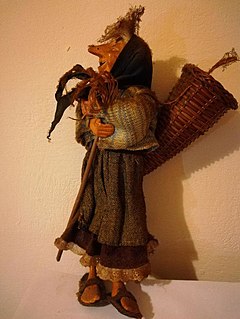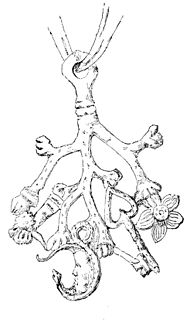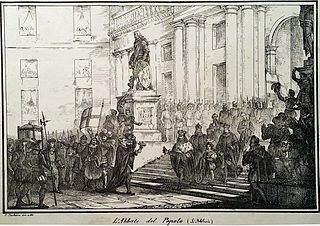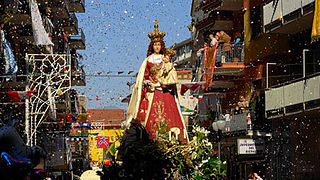 W
WThe Badalisc is a mythical creature of the Val Camonica, Italy, in the southern central Alps. The Badalisc is represented today as a creature with a big head covered with a goat skin, two small horns, a huge mouth and glowing eyes.
 W
WIn Italian folklore, Befana is an old woman who delivers gifts to children throughout Italy on Epiphany Eve in a similar way to St. Nicholas or Santa Claus.
 W
WThe boat of Saint Peter is a popular rural tradition prevalent in northern Italy, particularly in the geographical area of Friuli-Venezia Giulia, Veneto, Trentino, Lombardy, Liguria and Piedmont. This tradition is also widespread in certain valleys and territories of north-west Tuscany: Garfagnana and Val di Lima, Valleriana and Galciana.
 W
WThe cimaruta is an Italian folk amulet or talisman, traditionally worn around the neck or hung above an infant's bed to ward off the evil eye. Commonly made of silver, the amulet itself consists of several small apotropaic charms, with each individual piece attached to what is supposed to represent a branch of rue—the flowering medicinal herb for which the whole talisman is named, "cimaruta" being a Neapolitan form of cima di ruta: Italian for "sprig of rue".
 W
WCiocia is a modern Roman dialect's term to indicate a footwear of some mountainous areas of Southern and South-Eastern Europe, in particular Central and Southern Italy as well as the Balkans (opanci).
 W
WThe Confeugo is an ancient cultural event in Liguria, traditionally celebrated on Christmas Eve or a couple of days before Christmas. It is a historical event linked to the Republic of Genoa and is still commemorated today mainly in Genoa and Savona, but also in other Ligurian Municipalities that were once the seat of podesterie and capitaneati.
 W
WCarmine Crocco, known as Donatello or sometimes Donatelli, was an Italian brigand. Initially a soldier for the Bourbons, he later fought in the service of Giuseppe Garibaldi.
 W
WThe dahu is a legendary creature that resembles a mountain goat and is well known in France and francophone regions of Switzerland and Italy, including the Aosta Valley. The dahu, a quadrupedal mammal, may have been inspired by the chamois, a small, horned goat-antelope once plentiful in European mountainous regions, and also resembles the ibex.
 W
WAn egg of Columbus or Columbus' egg refers to a brilliant idea or discovery that seems simple or easy after the fact. The expression refers to an apocryphal story, dating from at least the 16th century, in which it is said that Christopher Columbus, having been told that finding a new trade route was inevitable and no great accomplishment, challenges his critics to make an egg stand on its tip. After his challengers give up, Columbus does it himself by tapping the egg on the table to flatten its tip.
 W
WThe feast of Saint Mary the Crowned of Carmel, commonly known as Our Lady of the Hens or Madonna of the Hens, is a religious and civil festival annually celebrated in Pagani, Campania.
 W
WThe Hundred-Horse Chestnut is the largest and oldest known chestnut tree in the world. Located on Linguaglossa road in Sant'Alfio, on the eastern slope of Mount Etna in Sicily — only 8 km (5.0 mi) from the volcano's crater — it is generally believed to be 2,000 to 4,000 years old. It is a sweet chestnut. Guinness World Records has listed it for the record of "Greatest Tree Girth Ever", noting that it had a circumference of 57.9 m (190 ft) when it was measured in 1780. Above ground, the tree has since split into multiple large trunks, but below ground, these trunks still share the same roots.
 W
WGiuseppe Musolino, also known as the "Brigante Musolino" or the "King of Aspromonte", was an Italian brigand and folk hero.
 W
WIn Alpine folklore, the Tatzelwurm or Stollenwurm, Stollwurm is a lizard-like creature, often described as having the face of a cat, with a serpent-like body which may be slender or stubby, with four short legs or two forelegs.
 W
WThe history or legend of the witches of Benevento is folklore dating from at least the 13th century. Its dissemination is one reason for the fame of this Samnite city. The popular belief—that Benevento would be the Italian witches' gathering place—has abundant implications, blurring the border between reality and imagination. Various writers, musicians, and artists have drawn inspiration from or referred to it.
 W
WThe Wolf of Gubbio was a wolf who, according to the Fioretti di San Francesco, terrorized the Umbrian city of Gubbio until he was tamed by St. Francis of Assisi acting on behalf of God. The story is one of many in Christian narrative that depicts saints exerting influence over animals and nature, a motif common to hagiography.